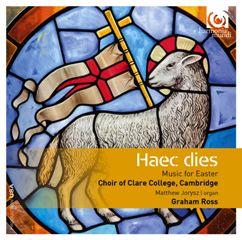Haec Dies - Music for Easter (2016)
Haec Dies - Music for Easter (2016)

1.Lassus: Aurora lucis rutilat 2.Taverner: Dum transisset Sabbatum 3.Plainchant: Resurrexi 4.Scheidt: Surrexit Christus hodie 5.Vaughan Williams: Easter 6.Plainchant: Haec dies 7.Byrd: Haec dies 8.Matthew Martin: Haec dies 9.Plainchant: Victimae paschali laudes 10.Bassano: Dic nobis Maria 11.Plainchant: Terra tremuit 12.Palestrina: Terra tremuit 13.Lassus: Surrexit pastor bonus 14.Haller: Surrexit pastor bonus 15.Byrd: Pascha nostrum 16.L'Héritier: Surrexit pastor bonus 17.Rachmaninov: Dnes' spaseniye 18.Wesley: Blessed be the God and Father 19.Hadley: My beloved spake 20.Stanford: Ye choirs of new Jerusalem 21.Lassus: Magnificat octavi toni super 'Aurora lucis rutilat' The Choir of Clare College, Cambridge Matthew Jorysz - organ Graham Ross - director
Liturgical choral music is something of a tradition unto itself, interacting only incompletely with the musical styles that surround it. Many albums, especially British, program Renaissance works together with contemporary pieces that follow their basic sound and polyphonic textures. More recently have come programs that attempt to reproduce the liturgies of specific junctures in church calendars, with the aim of heightening the significance of the texts and the composers' musical responses to them. This release from the Choir of Clare College, Cambridge, and director Graham Ross represents a nifty mixture of these two organizing principles. You have to get into the notes (or just read this review) to see it, but the program is divided into sections reflecting the music for Easter Day: Hymn at Lauds, Respond at Matins, Introit at Mass, Gradual at Mass, Sequence at Mass, Offertory at Mass, Motets, Communion at Mass, Anthems, and Magnificat at Vespers. These sections may include chant, one or more Renaissance works, and one or more Romantic or modern (but not very modern) works. At the center are three settings of the magnificent Easter gradual Haec dies, from chant to Byrd to the young English composer Matthew Martin (born 1976). Some of the juxtapositions are unexpected (such as the Communion set including Byrd again, the little-known French composer Jean L'Héritier, and Rachmaninov), but you can make a case for all the music being part of one large tradition known to some degree to all these composers. Sample the diverse but mysteriously linked Introit pair of pieces by Samuel Scheidt and Ralph Vaughan Williams (tracks four and five). The youthful mixed voices of the Clare College Choir have just the right feel of commitment to the text, and the sound is superb. Recommended. ---James Manheim, AllMusic Review
This collection of choral music for Easter covers most of musical history with plainchant, music from the Renaissance, and a selection of pieces running right up to modern times. I shall focus mainly on the earlier material, which is generally beautifully sung by the mixed voices of the Clare College Choir. If the opening account of Lassus’ Aurora lucis rutilat occasionally lacks the punch necessary to bring out its poly-choral structure, the narcotic account of Taverner’s Dum transisset which follows is exquisite. The lively Surrexit Christi hodie by Samuel Scheidt demonstrates the choir’s versatility, as does Byrd’s jubilant setting of Haec dies. Giovanni Bassano’s elegant Dic nobis Maria is given a lovely rhythmical rendition although Palestrina’s Terra tremui t is a trifle legato for my taste. Lassus’ Surrexit Pastor bonu s is also a little bland, but the choir warms again to Byrd’s Pascha nostrum. The disc is given a pleasing symmetry, ending with Lassus’ Magnificat octavi toni super Aurora lucis rutilat which is sung with vigour and a rich tone. The regular insertions of plainchant, which is also well sung, provides a useful time machine between the different eras. Probably my favourite track on the CD is the dramatic account of Stanford’s flamboyant Ye choirs of new Jerusalem. There is a great variety of musical styles represented here, and generally speaking the chorister rise to the challenge well, entering the idiom of each piece in turn. ---D. James Ross, earlymusicreview.com
download (mp3 @320 kbs):
